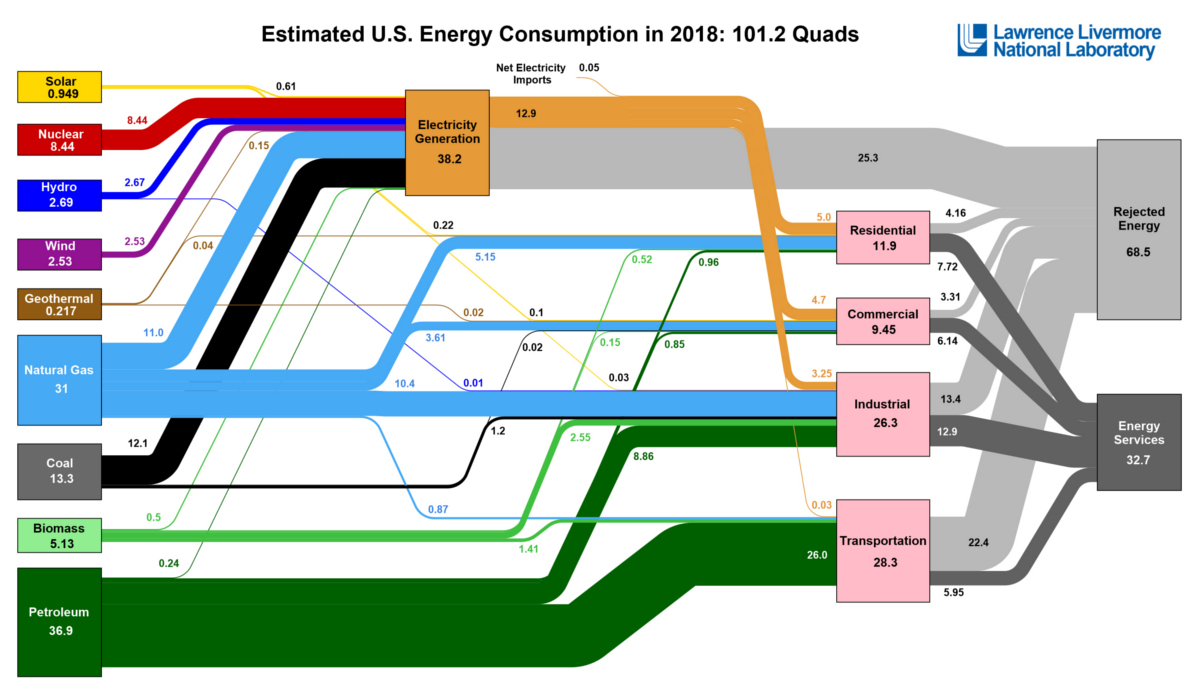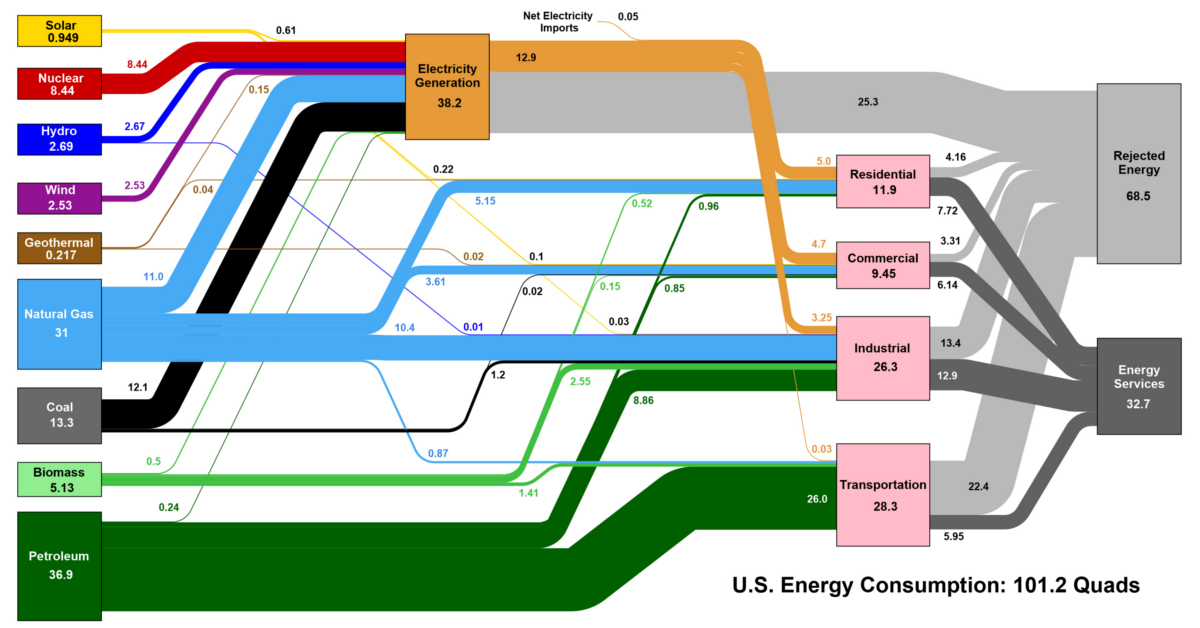Energy
Visualizing U.S. Energy Use in One Giant Chart

Visualizing U.S. Energy Use in One Giant Chart
If you feel like you’ve seen this diagram before, you probably have.
Every year, it’s assembled by the Lawrence Livermore National Laboratory, a research center founded by UC Berkeley and funded primarily by the U.S. Department of Energy.
The ambitious aim is to chart all U.S. energy use in one Sankey diagram, including the original energy source (i.e. nuclear, oil, wind, etc.) as well as the ultimate end use (i.e. residential, commercial, etc.) for the energy that was generated.
U.S. Energy Use in 2018
According to the research center’s most recent published version of the diagram, U.S. energy use totaled 101.2 quads in 2018.
In case you are wondering, a single quad is equal to 1 quadrillion BTUs, with each quad being roughly equivalent to 185 million barrels of crude oil, 8 billion gallons of gasoline, or 1 trillion cubic feet of natural gas.
Here is how the recent figure compares to previous years:
| Year | U.S. Energy Consumption | % Fossil Fuels in Mix |
|---|---|---|
| 2018 | 101.2 quads | 80.2% |
| 2017 | 97.7 quads | 80.0% |
| 2016 | 97.3 quads | 80.8% |
| 2015 | 97.2 quads | 81.6% |
| 2014 | 98.3 quads | 81.6% |
As you can see in the table, U.S. energy use has been generally increasing, eventually topping 100 quads per year by 2018. During this time, the total percentage of fossil fuels in the mix has dropped, but only from 81.6% to 80.2%.
Taking a closer look at the data, we can see that the largest percentage increases in the mix have come from solar and wind sources:
| Source | 2014 | 2015 | 2016 | 2017 | 2018 | Change ('14-'18) |
|---|---|---|---|---|---|---|
| Solar | 0.427 | 0.426 | 0.587 | 0.775 | 0.949 | +122% |
| Wind | 1.73 | 1.78 | 2.11 | 2.35 | 2.53 | +46% |
Energy use measured in quads (1 quadrillion BTUs)
Solar use has increased 122% since 2014, while wind jumped 46% over the same timeframe. Not surprisingly, energy derived from coal has fallen by 26%.
Dealing With the Rejects
One interesting thing about the diagram is that it also shows rejected energy, which represents the energy that actually gets wasted due to various inefficiencies. In fact, 68% of all energy generated is not harnessed for any productive use.
This makes sense, since gasoline engines are usually only about 20-40% efficient, and even electric engines are 85-90% efficient. Put another way, a certain percentage of energy is always released as heat, sound, light, or other forms that are hard for us to harness.
As electric cars rise in popularity and as modern gas-powered engines also get more efficient, there is hope that the amount of this rejected energy will decrease over time.
Energy
The World’s Biggest Nuclear Energy Producers
China has grown its nuclear capacity over the last decade, now ranking second on the list of top nuclear energy producers.

The World’s Biggest Nuclear Energy Producers
This was originally posted on our Voronoi app. Download the app for free on Apple or Android and discover incredible data-driven charts from a variety of trusted sources.
Scientists in South Korea recently broke a record in a nuclear fusion experiment. For 48 seconds, they sustained a temperature seven times that of the sun’s core.
But generating commercially viable energy from nuclear fusion still remains more science fiction than reality. Meanwhile, its more reliable sibling, nuclear fission, has been powering our world for many decades.
In this graphic, we visualized the top producers of nuclear energy by their share of the global total, measured in terawatt hours (TWh). Data for this was sourced from the Nuclear Energy Institute, last updated in August 2022.
Which Country Generates the Most Nuclear Energy?
Nuclear energy production in the U.S. is more than twice the amount produced by China (ranked second) and France (ranked third) put together. In total, the U.S. accounts for nearly 30% of global nuclear energy output.
However, nuclear power only accounts for one-fifth of America’s electricity supply. This is in contrast to France, which generates 60% of its electricity from nuclear plants.
| Rank | Country | Nuclear Energy Produced (TWh) | % of Total |
|---|---|---|---|
| 1 | 🇺🇸 U.S. | 772 | 29% |
| 2 | 🇨🇳 China | 383 | 14% |
| 3 | 🇫🇷 France | 363 | 14% |
| 4 | 🇷🇺 Russia | 208 | 8% |
| 5 | 🇰🇷 South Korea | 150 | 6% |
| 6 | 🇨🇦 Canada | 87 | 3% |
| 7 | 🇺🇦 Ukraine | 81 | 3% |
| 8 | 🇩🇪 Germany | 65 | 2% |
| 9 | 🇯🇵 Japan | 61 | 2% |
| 10 | 🇪🇸 Spain | 54 | 2% |
| 11 | 🇸🇪 Sweden | 51 | 2% |
| 12 | 🇧🇪 Belgium | 48 | 2% |
| 13 | 🇬🇧 UK | 42 | 2% |
| 14 | 🇮🇳 India | 40 | 2% |
| 15 | 🇨🇿 Czech Republic | 29 | 1% |
| N/A | 🌐 Other | 219 | 8% |
| N/A | 🌍 Total | 2,653 | 100% |
Another highlight is how China has rapidly grown its nuclear energy capabilities in the last decade. Between 2016 and 2021, for example, it increased its share of global nuclear energy output from less than 10% to more than 14%, overtaking France for second place.
On the opposite end, the UK’s share has slipped to 2% over the same time period.
Meanwhile, Ukraine has heavily relied on nuclear energy to power its grid. In March 2022, it lost access to its key Zaporizhzhia Nuclear Power Station after Russian forces wrested control of the facility. With six 1,000 MW reactors, the plant is one of the largest in Europe. It is currently not producing any power, and has been the site of recent drone attacks.
-

 Real Estate2 weeks ago
Real Estate2 weeks agoVisualizing America’s Shortage of Affordable Homes
-

 Technology1 week ago
Technology1 week agoRanked: Semiconductor Companies by Industry Revenue Share
-

 Money1 week ago
Money1 week agoWhich States Have the Highest Minimum Wage in America?
-

 Real Estate1 week ago
Real Estate1 week agoRanked: The Most Valuable Housing Markets in America
-

 Business1 week ago
Business1 week agoCharted: Big Four Market Share by S&P 500 Audits
-

 AI1 week ago
AI1 week agoThe Stock Performance of U.S. Chipmakers So Far in 2024
-

 Misc2 weeks ago
Misc2 weeks agoAlmost Every EV Stock is Down After Q1 2024
-

 Money2 weeks ago
Money2 weeks agoWhere Does One U.S. Tax Dollar Go?















